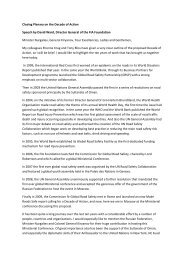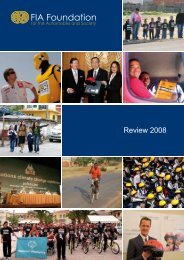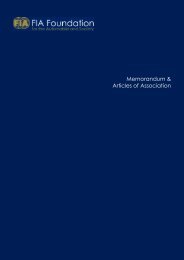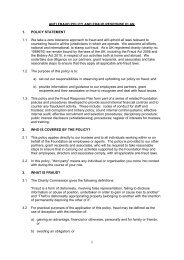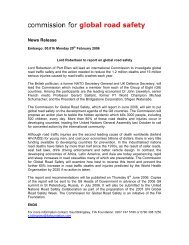Vehicle safety is global - Global NCAP
Vehicle safety is global - Global NCAP
Vehicle safety is global - Global NCAP
You also want an ePaper? Increase the reach of your titles
YUMPU automatically turns print PDFs into web optimized ePapers that Google loves.
iihs.org<br />
<strong>Vehicle</strong> Research Center<br />
988 Dairy Road<br />
Ruckersville, VA 22968<br />
USA<br />
T +1 (434) 985-4600<br />
vrc@iihs.org<br />
The Insurance Institute for Highway Safety, founded in 1959, <strong>is</strong> an independent,<br />
nonprofit, scientific, and educational organization dedicated to<br />
reducing the losses — deaths, injuries, and property damage — from<br />
crashes on the nation’s highways. The work of IIHS <strong>is</strong> wholly supported<br />
by U.S. insurers.<br />
The Institute’s <strong>Vehicle</strong> Research Center was dedicated in 1992, and<br />
crash research conducted there eventually led to IIHS front crashworthiness<br />
ratings in 1995. At the same time, IIHS was rating vehicle head<br />
restraint geometry to encourage designs better able to mitigate whiplash<br />
injuries. IIHS added side crashworthiness ratings in 2004 and also<br />
began basing its whiplash mitigation ratings on results of simulated rear<br />
crashes (sled tests). In 2009, IIHS began rating roof strength to promote<br />
better rollover crashworthiness.<br />
TOP SAFETY PICK, IIHS’s highest <strong>safety</strong> accolade, was initiated in<br />
2006 to help consumers easily identify those vehicle designs that had<br />
achieved the highest level of crashworthiness as indicated by results<br />
of IIHS tests. It has also been used to promote other life-saving <strong>safety</strong><br />
features such as electronic stability control (ESC). TOP SAFETY PICK<br />
continues to evolve, ever ra<strong>is</strong>ing the bar for <strong>safety</strong> in the U.S.<br />
CURRENT programs<br />
IIHS maintains front, side, roof, and whiplash mitigation ratings for about<br />
190 current model vehicle designs that represent about 92 percent of<br />
the new passenger vehicle fleet in the United States. Research using<br />
crash records indicates that occupants of vehicles with good ratings in<br />
IIHS tests have reduced r<strong>is</strong>k of injury and death:<br />
• In 2-vehicle frontal crashes, the driver fatality r<strong>is</strong>k in vehicles with<br />
good IIHS front ratings <strong>is</strong> 46 percent lower than in those rated poor.<br />
• Among vehicles with standard side airbags for the head and torso,<br />
those with good IIHS side crash ratings have a driver fatality r<strong>is</strong>k that<br />
<strong>is</strong> 70 percent less than that of those rated poor.<br />
• Research that led to the initiation of IIHS roof strength tests<br />
indicates that the r<strong>is</strong>k of serious injury or death <strong>is</strong> reduced by 34<br />
percent in rollover crashes among good-rated vehicles compared<br />
with poor ones.<br />
• The r<strong>is</strong>k of neck injury in rear crashes <strong>is</strong> 15 percent lower for drivers<br />
in seats with good ratings than for those in seats rated poor. For<br />
injuries lasting 3 months or more, the difference <strong>is</strong> 35 percent.<br />
In addition to front, side, roof, and rear <strong>safety</strong> crash ratings, IIHS<br />
rates vehicle bumpers for their ability to prevent expensive damage<br />
in low-speed crashes. Since 2008, IIHS has rated belt-fitting booster<br />
seats for their ability to correctly position <strong>safety</strong> belts on children in a<br />
variety of vehicles.<br />
fUTURE plans<br />
IIHS researchers are developing a new frontal crash test to evaluate<br />
a vehicle’s ability to protect occupants in frontal crashes with smaller<br />
overlap than the current IIHS frontal test.<br />
IIHS researchers are monitoring real-world performance of driver ass<strong>is</strong>tance<br />
and crash avoidance technologies with the intention of promoting<br />
those that are shown to be effective at helping drivers avoid crashes.<br />
Recent IIHS research suggests the possible need for compar<strong>is</strong>on testing<br />
of heavy truck underride guards.




